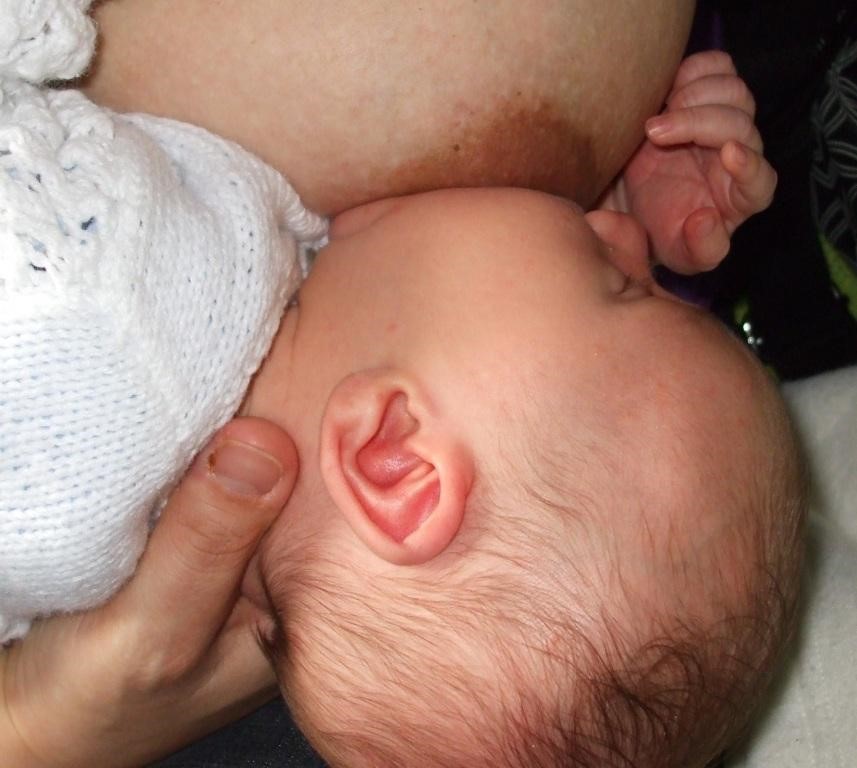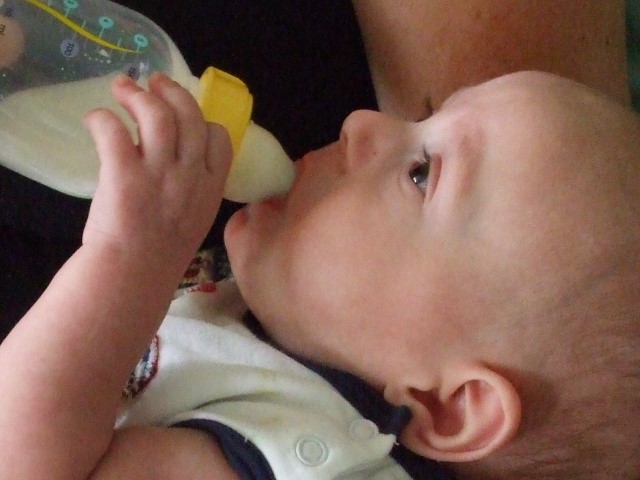Truly, if all the folklore about burping, wind and colic were true, every baby on the planet would be air-borne!
The Tradition of Burping
Burping appears to be an entirely Western cultural tradition. After feeding, the baby is held upright and patted/pounded on the back until s/he emits at least one obvious belch of air swallowed during the feed. Popular belief is that if this is not done, the swallowed air builds up to cause colic, also called “wind pain”. Many are the hours that have been wasted by anxious parents whose burping efforts have not achieved this magical expulsion. Happy are the parents who can boast of a baby who is “a good burper”!
Common Beliefs About Burping:
- Swallowed air causes “colic.”
- Air moves from the stomach to the intestines if not released.
- Burping helps prevent colic.
Although there is actually no evidence to support such beliefs, it has not prevented the marketing of “wind mixtures” and “anti-colic” teats and bottles to reinforce the folklore.
What Does “Wind” Really Mean?“
Wind” consumes a great deal of parental attention. When parents comment that they have a “windy baby”, it is helpful to ask which end of the baby is blowing. Western parents worry over babies who do not expel wind orally or who part with large amounts of it orally or anally. Clinically, it can be observed that oral and anal “wind” expulsions mean two entirely different things. There is evidence to support these statements.
Although sometimes indicating that s/he is not having the ideal feeding experience, the air “burped up” by a baby is in itself relatively inconsequential. To swallow large amounts of air during feeding, a baby has to have a fairly noisy feeding technique. These babies, whether breast- or bottle-fed, often swallow audibly while feeding. (Figure 1 sets out the reasons for this.) Babies, like adults, will simply burp up excess air when in a position that allows it. This is usually an upright position, but can be any position, including lying down or at the breast.


Contrasting with the poorly attached baby above, the optimally attached baby (left) is more likely to have a quiet feed, therefore swallowing less air than poorly attached babies may do.
The features of optimal attachment include:
- Nipple directed deeply into baby’s mouth on attachment
- (Nipple does not need to be pointed at baby’s nose!)
- Baby’s chin pressed into the breast all through the feed
- Baby’s head falls away from the breast – nothing pushing against the back of the head
- Lower lip not visible
All the above automatically achieves asymmetric attachment, with more breast in baby’s mouth below the nipple than above
The main reason that we burp babies in Western countries is that we expect to put them down after feeding. If the baby does not burp in an upright position, milk is more likely to be vomited back along with the swallowed air. Having gone to some trouble to get milk into the baby, parents don’t regard pools of regurgitated milk on themselves and the floor as a positive experience!
Burping an upright baby as dictated by Western custom (in theory) helps parents avoid excessive milky possets (small vomits) by allowing air bubbles to rise above the milk before the baby burps. In most traditional cultures, babies are carried upright all day in slings or on someone’s hip, which automatically “burps” babies without the effort believed to be so important in our culture.
Emphasising burping is an unhelpful distraction for parents of babies who vomit beyond the first few weeks of life, because ongoing infant vomiting is more likely to be linked with food allergy and food intolerance. Many of these babies can also be described as “colicky”.
Reasons for Audible Swallowing
During breastfeeds:
|
|
|
|
During bottle feeds:
|
|
|

Logically, these varied teat designs cannot all be ideal for human babies – there is too much variation between them.. The best teat is indicated by the heart directly above it. Research has shown this old fashioned long barrel teat – preferably made of rubber (latex) – to be the best possible design, most closely approximating a breastfeeding suck, as long as the end of the teat rests in the back of the baby’s mouth.
Bottlefed babies generally swallow more air during feeds because even the best teat design currently available does not permit the baby to feed in a completely natural manner. Despite manufacturers’ claims, “New Age” teat designs such as those pictured above do not allow normal tongue actions or optimal co-ordination of breathing with sucking and swallowing


The baby on the left (above) has major feeding problems and cannot feed normally from a barrel teat – this is as far as he can tolerate the teat in his mouth. By contrast, the baby on the right is coping very well with the same style of long barrel teat, with his lower lip touching the flange that screws the teat onto the bottle.
Unfortunately, general paranoia about swallowed air can lead to further unpleasant feeding experiences for bottle fed babies near the end of feeds if bottles are held at increasingly impossible angles to try to keep the teat filled with milk. If the end of the teat is pressed down into the baby’s tongue, the result is feeding discomfort and a tendency to choke, cough and gag.
The person feeding the baby with a bottle should not impose anything unpleasant on the baby, being aware of the baby’s comfort. Feeding should always be a pleasant experience that respects the baby’s personal autonomy as a human being.
Colic and Feeding Techniques
“Colic” is not a very helpful term because it means different things to different people. To some, colic is simply unexplained crying, especially if it seems related to infant pain. I define colic as being due to an excess of fermented gases in the baby’s intestinal tract, causing pain, unsettled behaviour, disturbed sleep and episodes of crying/screaming.
A colicky baby is quite flatulent, tending towards frequent explosive, watery bowel motions. These can vary in colour between green, brown, grey, orange and yellow. Some label this set of symptoms “lactose intolerance”, but this condition does not truly exist in children under 5 years of age. It is more helpful to look for the cause of the symptoms so they can be dealt with – the colic then disappears.
Obviously quite different to air composition (mostly nitrogen, carbon dioxide and oxygen), the fermented gases causing such unpleasant symptoms are carbon dioxide, hydrogen and methane. Under suitable conditions, large amounts of these gases are fermented by intestinal microbes from the lactose in a baby’s milk feeds. Although often labelled as “lactose intolerance”, it is a distracting focus on lactose as the culprit – a misinterpretation of its role in this scenario. Lactose is at the end of this particular story, not the start.
Understanding Lactose and Infant Digestion
Lactase is an enzyme made by the cells of the brush border of the small intestine. Without lactase, we cannot digest lactose, a disaccharide sugar composed of the simple sugars glucose and galactose. Under the action of lactase, the chemical bond joining these two simple sugars is split, allowing glucose and galactose to be absorbed into the body. Without sufficient lactase, the excess lactose is fermented by gastrointestinal bacteria, producing gas and acid.
A diagnosis of lactose intolerance can reasonably be made only when a genetic or congenital manifestation of lactase insufficiency occurs. This happens extremely rarely in babies as congenital primary lactose intolerance. These babies have no capacity to make their own lactase. Others who are born with congenital bowel conditions may have varying degrees of lactase sufficiency. Premature babies may also have limited lactase sufficiency until they are more mature. The common form of true lactose intolerance develops in varying degrees of severity from the age of 5 onwards in about 70% of the world’s human gene pool. Therefore those of us who retain a full capacity to make lactase as adults can regard ourselves as genetic oddities!
Other temporary forms of lactose intolerance can happen at any time in life as a result of damage to the lining of the small intestine. Bowel infections and food allergies cause this type of damage.
Some breastfed babies develop symptoms purely as a result of feeds containing too little fat. It leads to milk passing too quickly from the stomach into the small intestine, which simply cannot make lactase fast enough to cope and may happen if:
- mothers do not have enough fats/oils in their diets (dieting, missing meals, eating poorly) and/or
- breastfeeds end before the baby has finished the feed (because of nipple damage, breast pain, babies who are ineffective breastfeeders, timed feeding regimes).
Although lactose is important to babies for a number of reasons (see Figure 2), its primary importance is its role in infant brain development. Levels of lactose in the various mammal milks generally correlate to the size of the brains those mammals are genetically programmed to grow. Human milk has the highest lactose levels of all mammal milks. The galactose component of lactose is directly incorporated into the cells of the brain and the rest of the central nervous system as galactolipids. Whether breast or artificially fed, babies are not supplied with galactose other than through lactose digestion. It immediately raises the issue of potentially serious risks to babies who are fed soy milks in their early years, summarised in Figure 2.
Why do human babies need lactose? | Particular deficiencies of soy infant formulae |
· to supply 40% of energy needs | · no lactose |
· to facilitate calcium absorption | · soy is just as potentially allergenic as cow milk |
· to facilitate iron absorption | · high aluminium content |
· to reduce the risks of GIT infection | · high phytoestrogen levels |
· for healthy growth and development of the brain | · safety is unsubstantiated by research |
Where to from here?
Holding a baby upright after feeds may help reduce vomiting and infant discomfort. Parents soon work out if it is so or not. Babies are unique individuals.
It is certainly time for a clearer understanding of “wind” issues, so parents and the rest of the western community are freed from unnecessary burdens of preoccupation and anxiety about it. If there is a problem with excess intestinal gas production, the good news is that it can be resolved once the cause is identified and dealt with.

